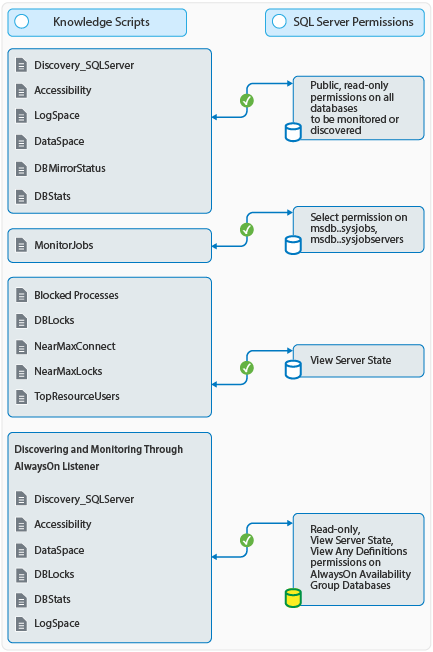3.0 SQL Server Knowledge Scripts
AppManager provides the following Knowledge Scripts for monitoring SQL Server version 2005 and later. The SQLServer category of Knowledge Scripts is supported for SQL Server resources installed in clustered and non-clustered environments.
When deciding which Knowledge Scripts to run and the appropriate threshold values to use, consider how other applications you manage are dependent on SQL Server.
To run these Knowledge Scripts, you must require a minimum of Public and read-only SQL Server permissions. There are few Knowledge Scripts that require specific SQL Server permission. The following graphic displays the permissions required to run the Knowledge Scripts.x

From the Knowledge Script view of Control Center, you can access more information about any NetIQ-supported Knowledge Script by selecting it and clicking Help. In the Operator Console, click any Knowledge Script in the Knowledge Script pane and press F1.
|
Knowledge Script |
What It Does |
|---|---|
|
Monitors SQL Server database accessibility and raises an event if specified database is not accessible. |
|
|
Monitors the AlwaysOn Availability Group health status, replica synchronization status, replica failover readiness, and operational status. |
|
|
Determines the node ownership of a SQL Server AlwaysOn Availability Group. |
|
|
Monitors SQL Server backup jobs to track data backup activities optimally. |
|
|
Monitors the number of SQL Server processes that have been queued for longer than the period of time you specify. |
|
|
Monitors the percentage at which the requested data page is retrieved from the SQL Server cache without performing physical reads from disk. |
|
|
Monitors SQL Server connectivity and raises an event if the server is not available during the monitoring interval. |
|
|
Monitors the percentage of CPU used by SQL Server processes. |
|
|
Monitors the available data space and the percentage of data space used by each database. |
|
|
Monitors the number of locks per SQL Server database and raises an event if the number of locks exceeds the threshold you specify. |
|
|
Monitors the status of each mirrored database. |
|
|
Monitors the percentage of used space for data and log files. |
|
|
Monitors the SQL Server error logs and looks for any error log entries that have appeared since the last monitoring interval. This script also scans the error log entries for any new entries created since the last time it checked. |
|
|
Monitors log shipping status. |
|
|
Monitors the available log space and used log space of a database and raises an event if the available log space falls below the threshold, or if the percentage of log space used exceeds the threshold you specify. |
|
|
Monitors the amount of memory used by SQL Server processes. |
|
|
Reports on any scheduled jobs that have not completed successfully. |
|
|
Monitors the number of used connections compared to the maximum concurrent connections configured for the SQL Server |
|
|
Monitors the used number of locks compared to the maximum available locks configured for the SQL Server. |
|
|
Runs T-SQL statements or stored procedures. |
|
|
Monitors the up or down status of SQL Server and also identifies the downtime of the SQL Server since the server was started. |
|
|
Determines the node ownership of a SQL Server failover cluster instance. |
|
|
Monitors the total CPU time used by SQL Server users, the number of IO operations performed, the total number of locks held by all SQL Server users and their connections, and the number of memory pages that can be allocated to all SQL Server users and their connections. |
|
|
Monitors the total number of user connections currently connected to SQL Server and raises an event if the total number of user connections exceeds the threshold you specify. |